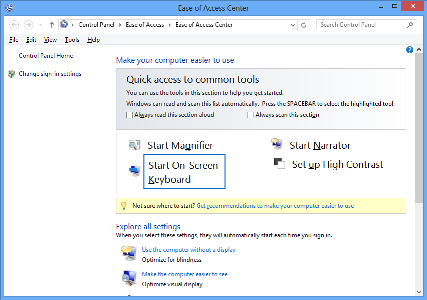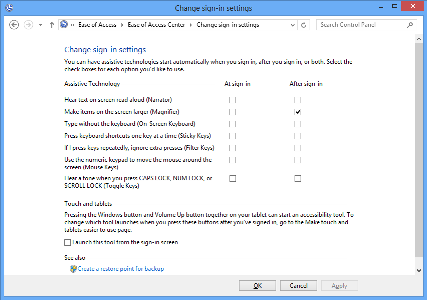Windows 8 and the slightly updated 8.1 marked a significant change from Windows 7 due to the introduction of features based on the use of a touch-screen device. While this led to significant improvement in the built-in accessibility features over Windows 7, many users found it difficult to use the touch-screen optimised environment using a traditional mouse and keyboard.
Media Access Australia recommends that Windows 8.1 users strongly consider upgrading to Windows 10 if their assistive technology software supports it. The primary benefit of Windows 10 over Windows 8.1 is that the interface is more like Windows 7, but with the ability to enable ‘tablet mode’ should users want to make it more like Windows 8.1. However, if you prefer to use Windows 8.1, or are unable to uprade, there are a number of accessibility improvements in addition to the accessibility features carried over from Windows 7.
Windows 8.1 Accessibility
The built-in accessibility features have been updated to work with touchscreen devices. In addition, some new features have been added to make it easier for a user to have accessibility features start when the computer starts.
Updated assistive features
The following assistive features have been updated or introduced:
- Narrator: improved performance, extra language support, new voices, better application support and touch-enabled
- Magnifier: support for high contrast colour schemes and a new interface for touchscreen devices
- Sign-in settings: allows the user to select which built-in accessibility features launch as the computer starts up
- Accessible apps: the new Windows Store feature in Windows 8.1 allows the user to search only for apps which the developer has certified as accessible. There are also features that can help developers create accessible applications.
Finding and launching accessibility features

Keyboard users:
If you are using a traditional computer to run Windows 8.1, most of the keyboard shortcuts remain the same from Windows 7. For example, the Ease of Access Center can still be launched by holding down the Windows key and pressing the ‘U’ key.
Mouse and touch screen users
Due to the optimisation of Windows for touch-enabled devices such as tablets, the Start menu and applications have been significantly redesigned. To find the Ease of Access Center using a mouse or touch screen:
- Open the Start Menu
- Open the Charms bar my touching or moving the mouse arrow to the top or bottom right corner of the screen
- Select ‘Search’
- In the search options, select ‘Settings’
- Type in ‘Ease of Access Center’ using the on-screen keyboard
- Select the Ease of Access Center application
Once the Ease of Access Center is opened, the various accessibility features can be launched the same way as in Windows 7.
Touchscreen enhancements to accessibility features
Narrator
In Windows 8.1, the Narrator screen reader features the ability to explore Windows and applications by touch.
To launch Narrator on a touchscreen device, hold down the Windows button and press the ‘volume up’ button.
Once launched, Narrator will provide a verbal feedback as the user moves their finger around the screen. An element can then be selected by tapping the screen with a second finger.
Magnifier
The inbuilt screen magnifier has also been optimised for touch. When Magnifier is launched, bars appear around the screen which allows the user to navigate the zoom. Gesturing up or down on the vertical bars, and left or right on the horizontal bars, provides the user with navigation around the magnified area. The corners, when touched, allow the user to zoom in and out.
Changing the sign-in accessibility settings

Windows 8.1 also allows you to easily configure which accessibility features you would like to automatically start when your computer starts. To access the sign-in settings screen, launch the Ease of Access Centre as discussed above, then select the ‘Change sign-in settings’ option.
The screen provides a series of checkboxes for a number of Windows accessibility features including Narrator, Magnifier, on-screen keyboard, sticky keys, filter keys, mouse keys and toggle keys. You can choose to either enable these features at sign-in or after sign-in by ticking the relevant box.
Top of page

